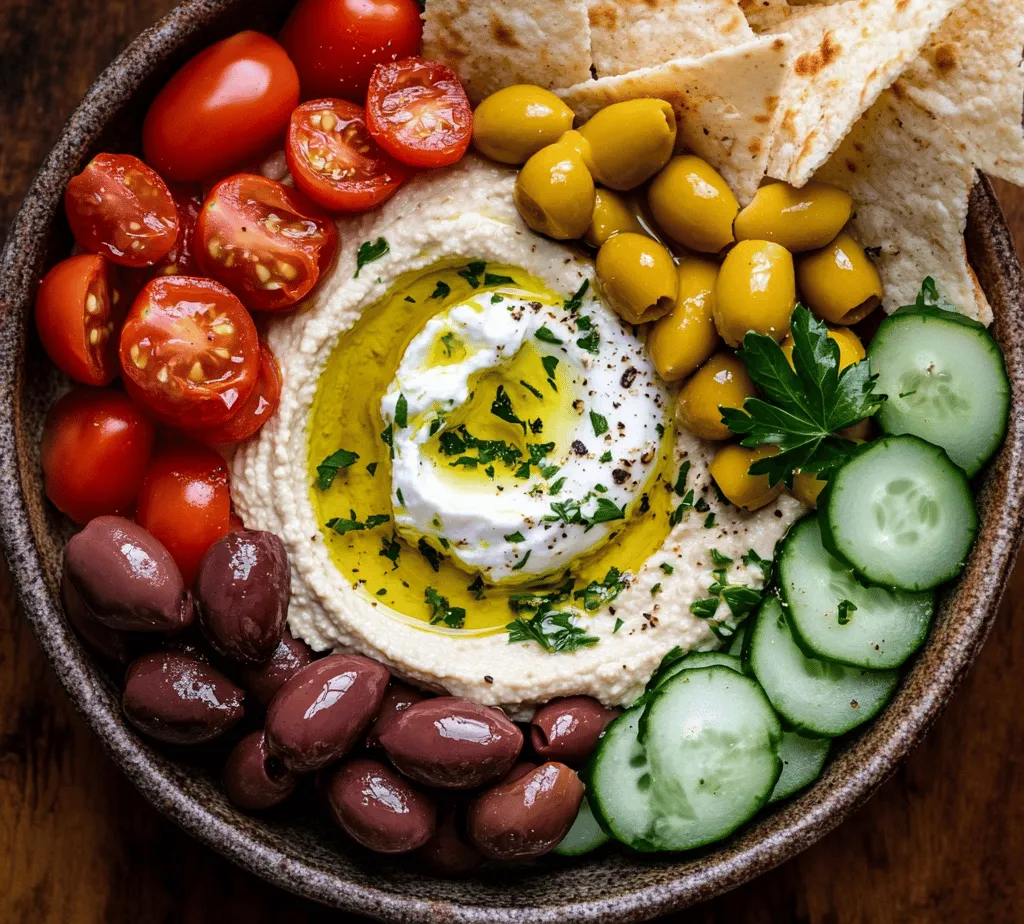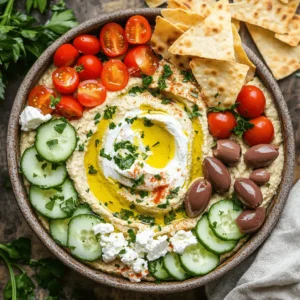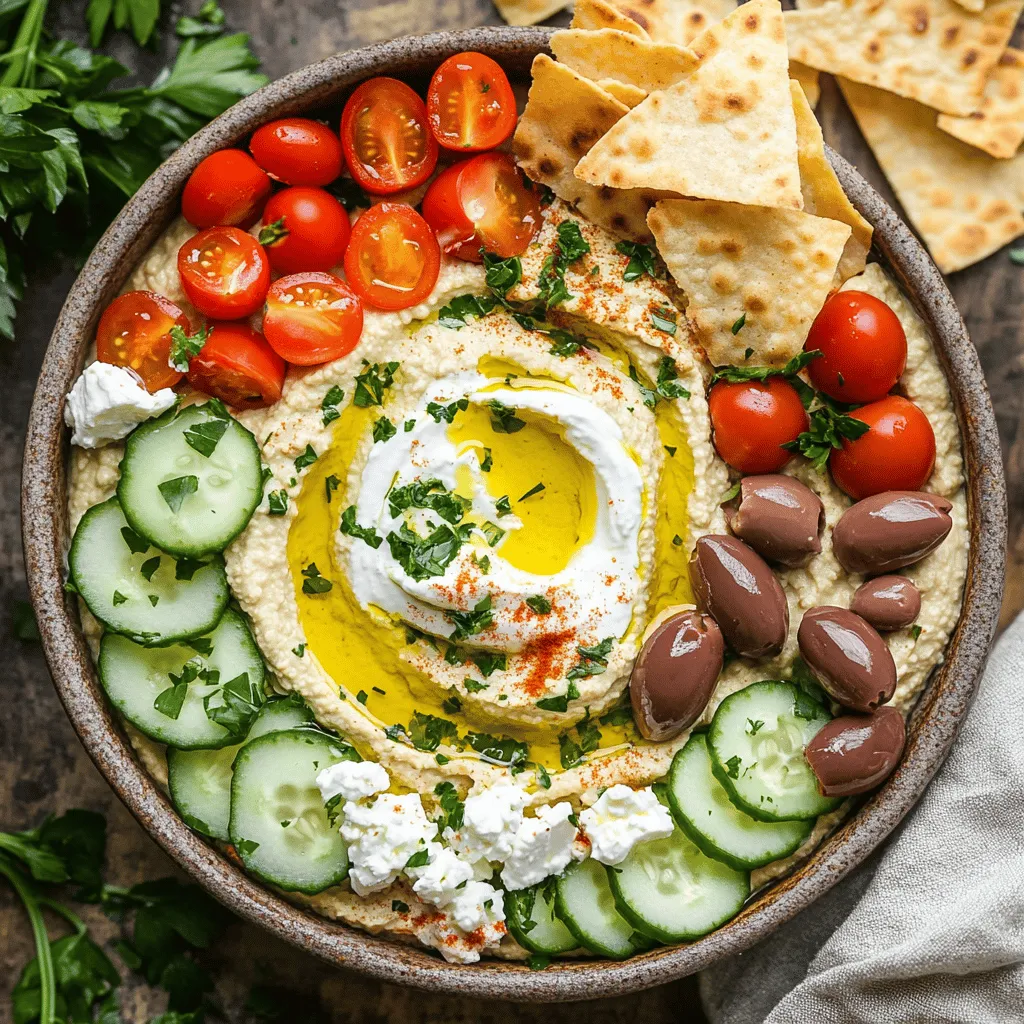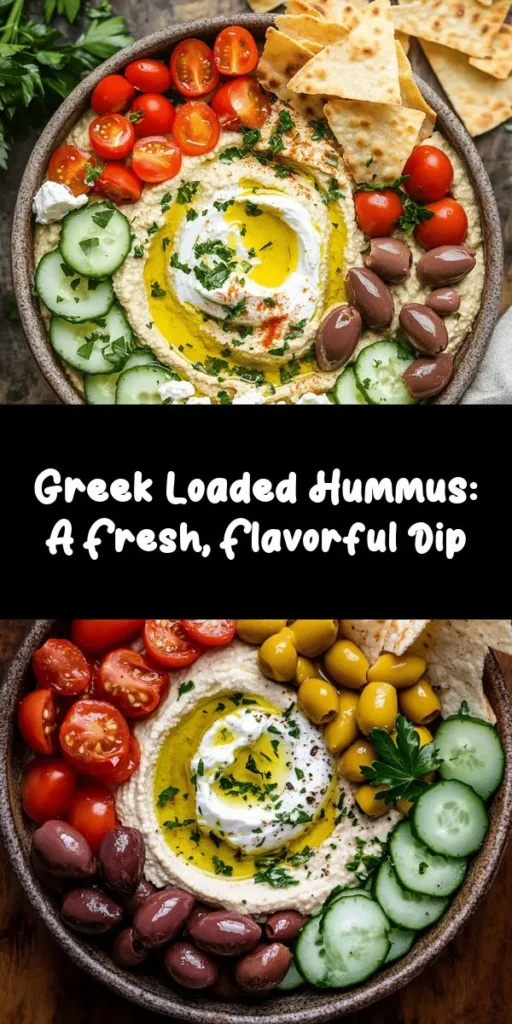Introduction
Hummus has taken the culinary world by storm, becoming a staple in kitchens and restaurants alike. This delicious dip, with its creamy texture and nutty flavor, has origins that trace back to the Middle East, where it has been enjoyed for centuries. In recent years, its popularity has transcended borders, becoming a beloved dish in various cultures, especially within the Mediterranean region. The appeal of Greek cuisine lies in its emphasis on fresh, high-quality ingredients that not only tantalize the taste buds but also promote health and well-being.
Enter Greek Style Loaded Hummus, a delightful twist on the classic hummus recipe that showcases the vibrant flavors of Greek cooking. This dish is not just a dip; it’s a versatile delight that can be served as an appetizer, snack, or even as a light meal. With its rich combination of textures and flavors, Greek Style Loaded Hummus is perfect for gatherings, picnics, or a cozy evening at home.
In this article, we will explore the history and cultural significance of hummus, dive into the nutritional benefits of its key ingredients, and provide you with a step-by-step guide to creating this flavorful dish in your own kitchen.
Understanding Hummus: A Brief History
The origins of hummus can be traced back to the Middle East, with its roots deeply embedded in various cultures that have claimed it as their own. While the exact birthplace of hummus remains a topic of debate, it is widely accepted that this dish has been enjoyed for centuries, with references to chickpea-based spreads appearing in ancient texts. Over time, hummus has evolved, adapting to regional tastes and preferences, which has contributed to its global fame.
As hummus made its way across borders, it became a symbol of Middle Eastern culinary heritage. Its simple yet delicious combination of chickpeas, tahini, lemon, and garlic has resonated with food lovers worldwide. Today, hummus is not only a popular dip served with pita bread or fresh vegetables, but it has also inspired countless variations, including flavored hummus and loaded versions like our Greek Style Loaded Hummus.
From a nutritional standpoint, hummus is a powerhouse of health benefits. Chickpeas, the primary ingredient, are an excellent source of plant-based protein, fiber, and essential vitamins and minerals. They are known to support digestive health, aid in weight management, and may even help regulate blood sugar levels. Tahini, made from ground sesame seeds, adds a creamy texture while providing healthy fats, calcium, and antioxidants. Together, these ingredients create a wholesome dish that is not only satisfying but also nourishing.
Ingredients Spotlight
To create the perfect Greek Style Loaded Hummus, it’s essential to understand the role of each ingredient and the benefits they bring to the table. Here’s a detailed look at the key components that make this dish a flavorful Mediterranean delight.
Chickpeas
Chickpeas are the star of any hummus recipe. These legumes are packed with protein, fiber, and a variety of essential nutrients, making them a healthy choice for any diet. When preparing hummus, you can use canned chickpeas for convenience or opt for dried chickpeas for a more traditional approach. If using dried chickpeas, soak them overnight and cook them until tender to achieve the best texture in your hummus. The creaminess of the hummus largely depends on how well the chickpeas are blended, so ensuring they are well-cooked is crucial for a smooth consistency.
Tahini
Tahini is a key ingredient in hummus that contributes to its rich, creamy texture. Made from ground sesame seeds, tahini adds a nutty flavor that complements the chickpeas beautifully. Beyond its taste, tahini is also a nutritional powerhouse, rich in healthy fats, protein, and various vitamins and minerals, including calcium and magnesium. When purchasing tahini, look for high-quality brands that use whole sesame seeds, as this will enhance the flavor and nutritional value of your dish.
Olive Oil
The choice of olive oil can significantly impact the flavor profile of your hummus. High-quality olive oil is a staple in Greek cuisine known for its rich taste and numerous health benefits. It is packed with monounsaturated fats and antioxidants that can promote heart health and reduce inflammation. When preparing Greek Style Loaded Hummus, a generous drizzle of extra virgin olive oil not only enhances the flavor but also adds a luxurious finish to the dish.
Fresh Produce
Fresh ingredients are at the heart of Greek cuisine, and they play a vital role in our loaded hummus recipe. Fresh lemon juice adds brightness and acidity, balancing the richness of the tahini and olive oil. Garlic brings a robust flavor that elevates the overall taste of the hummus. Toppings such as diced tomatoes, cucumber, and fresh parsley not only provide visual appeal but also contribute refreshing flavors and textures that complement the creamy base.
Greek Yogurt
To achieve a velvety smooth texture and a tangy flavor, Greek yogurt is a fantastic addition to our hummus. It adds an extra layer of creaminess and a touch of acidity, enhancing the overall taste of the dish. Greek yogurt is also high in protein and probiotics, making it a nutritious choice that aligns with the health benefits of the other ingredients.
Feta and Kalamata Olives
No Greek dish is complete without the bold flavors of feta cheese and Kalamata olives. Feta adds a salty, tangy element that contrasts beautifully with the creaminess of the hummus, while Kalamata olives provide a briny depth of flavor. These ingredients are not just traditional; they are essential to capturing the essence of Greek cuisine in our loaded hummus.
Step-by-Step Preparation of Greek Style Loaded Hummus
Now that we’ve explored the ingredients, let’s dive into the step-by-step preparation of Greek Style Loaded Hummus. This recipe is easy to follow, even for beginners, and the end result is sure to impress your family and friends.
Preparing the Base Hummus
1. Combine Ingredients: Start by gathering your chickpeas, tahini, garlic, lemon juice, and olive oil in a food processor. If you prefer a smoother hummus, it’s beneficial to remove the skins from the chickpeas, though this step is optional. Adding a pinch of salt will enhance the overall flavor.
2. Blend for Creaminess: Pulse the mixture until it becomes a thick paste. Gradually add cold water, one tablespoon at a time, while blending to achieve your desired consistency. The goal is to create a smooth, creamy texture, so be patient and blend thoroughly.
3. Taste and Adjust: Once blended, taste your hummus and adjust the seasoning as needed. You may want to add more lemon juice for acidity, garlic for pungency, or salt for flavor. This step is crucial in achieving a well-balanced taste.
Creating the Well for Greek Yogurt
4. Transfer to Serving Dish: Once your hummus is perfectly blended, transfer it to a shallow serving dish. Using the back of a spoon, create a well in the center of the hummus. This well will hold the Greek yogurt and toppings, creating a beautiful presentation.
Arranging Toppings
5. Add Greek Yogurt: Spoon a generous amount of Greek yogurt into the well you created. The yogurt should be slightly heaped to create an inviting look. The contrast between the creamy hummus and the tangy yogurt is visually appealing and adds depth to the dish.
6. Garnish with Fresh Produce: Now, it’s time to make your Greek Style Loaded Hummus visually stunning. Arrange diced tomatoes and cucumber around the well, creating a colorful display. Sprinkle crumbled feta cheese and sliced Kalamata olives on top of the yogurt for added flavor and texture.
Drizzling Olive Oil and Garnishing with Parsley
7. Finish with Olive Oil: Drizzle high-quality extra virgin olive oil over the entire dish, focusing on the yogurt and toppings. This not only enhances the flavor but also adds a glossy finish that makes the dish irresistible.
8. Garnish with Fresh Herbs: Finally, sprinkle freshly chopped parsley over the top for a burst of color and freshness. The herbs will add an aromatic touch that elevates the dish even further.
By following these steps, you’ll create a stunning Greek Style Loaded Hummus that is bursting with flavor and perfect for any occasion. Whether served at a gathering, as a midday snack, or as part of a Mediterranean-inspired meal, this dish is sure to impress and delight those who taste it.

Serving Suggestions and Pairings
When it comes to enjoying your Greek Style Loaded Hummus, the way you serve it can elevate the entire experience. Here are some ideal serving options and creative ideas to make the most of this delightful dish.
Pita Chips vs. Fresh Pita Bread
One of the most popular choices for serving hummus is alongside pita bread. Fresh pita bread is soft, pillowy, and perfect for scooping up generous portions of hummus. You can warm it slightly in the oven or on a skillet to enhance its flavor and texture.
On the other hand, pita chips add a satisfying crunch that complements the creamy texture of the hummus. They are often seasoned with spices such as garlic powder, paprika, or even za’atar for an extra flavor kick. Both options cater to different preferences, so consider providing a mix of fresh pita and pita chips to accommodate all tastes.
Accompanying Dishes: Suggestions for a Complete Mediterranean-Themed Meal
If you’re planning to serve Greek Style Loaded Hummus as part of a larger spread, here are some dishes that pair beautifully:
– Tabbouleh Salad: This refreshing salad made with parsley, tomatoes, bulgur, and mint is a fantastic complement, adding freshness and vibrant flavors.
– Stuffed Grape Leaves (Dolmas): These are perfect for a Mediterranean feast. The tangy rice and herb filling pairs wonderfully with the hummus.
– Grilled Vegetables: Zucchini, eggplant, and bell peppers drizzled with olive oil and herbs can add a smoky flavor that balances the dish.
– Greek Salad: A classic Greek salad with feta, olives, and cucumbers adds an extra layer of flavor and is a nutritious option to serve alongside your hummus.
Creative Serving Ideas: Using Hummus as a Dip, Spread, or Part of a Mezze Platter
While hummus is traditionally served as a dip, its versatility allows for numerous creative serving ideas. Here are a few:
– As a Dip: Serve your hummus with an array of fresh vegetables like carrot sticks, cucumber slices, and bell pepper strips for a healthy snack.
– As a Spread: Use hummus as a spread on sandwiches or wraps. Layer it with grilled chicken, fresh greens, and roasted red peppers for a delicious Mediterranean-inspired lunch.
– As Part of a Mezze Platter: Combine your hummus with olives, feta cheese, roasted nuts, and other dips like baba ganoush or tzatziki for an impressive mezze platter that’s perfect for entertaining.
Nutritional Information and Health Benefits
Greek Style Loaded Hummus is not only delicious but also packed with nutrients. Here’s a breakdown of the nutritional content per serving:
– Calories: Approximately 150-200 calories, depending on the toppings.
– Protein: About 5-7 grams, mainly from chickpeas and Greek yogurt.
– Fiber: Roughly 4 grams, which supports digestive health.
– Healthy Fats: Contains around 5-6 grams of healthy fats from tahini and olive oil.
Discussion of Health Benefits Associated with the Ingredients
The ingredients in Greek Style Loaded Hummus offer numerous health benefits:
– Chickpeas: Rich in protein and fiber, chickpeas help keep you full and satisfied, making them an excellent choice for weight management.
– Tahini: This sesame seed paste is a source of healthy fats and is high in calcium, supporting bone health.
– Fresh Vegetables and Herbs: Ingredients like cucumbers, tomatoes, and parsley are loaded with antioxidants and vitamins, contributing to overall health and wellness.
– Greek Yogurt: This ingredient not only adds creaminess but also provides probiotics, which are beneficial for gut health.
Customization and Variations
One of the best aspects of making Greek Style Loaded Hummus is how easy it is to customize according to your tastes or dietary needs.
Ideas for Making the Recipe Your Own
– Adding Roasted Vegetables: Incorporate roasted red peppers, eggplant, or zucchini into your hummus for added flavor and nutrition.
– Different Herbs: Experiment with different herbs such as dill, cilantro, or chives to give your hummus a unique twist.
– Alternative Toppings: Get creative with toppings! Sun-dried tomatoes, artichokes, or even a sprinkle of feta cheese can add new dimensions to your dish.
Adapting for Dietary Restrictions: Vegan Options and Ingredient Substitutions
For those following a vegan diet, Greek yogurt can be substituted with a plant-based yogurt alternative. Additionally, ensure that the tahini and any added toppings are vegan-friendly.
If you want to reduce calories, you can also consider using less olive oil or substituting some of the tahini with a lower-calorie ingredient like avocado to maintain creaminess without extra calories.
Storing and Preserving Your Hummus
After enjoying your Greek Style Loaded Hummus, you may find yourself with leftovers. Here are some best practices for storing and preserving your hummus:
– Best Practices for Storing Leftover Hummus: Transfer any leftover hummus to an airtight container. Ensure that the container is sealed tightly to prevent air from entering, which can cause the hummus to dry out.
– Shelf Life and Tips for Maintaining Freshness: When properly stored in the refrigerator, your hummus will last for about 4-5 days. To maintain freshness, consider drizzling a thin layer of olive oil over the surface before sealing the container.
– Ideas for Repurposing Hummus in Other Dishes: Hummus can be used in various ways beyond just a dip. Spread it on sandwiches, use it as a base for savory tarts, or incorporate it into pasta dishes for added creaminess.
Conclusion
Making Greek Style Loaded Hummus at home is a delightful culinary adventure that brings the Mediterranean flavors to your kitchen. Whether enjoyed as a dip, spread, or part of a mezze platter, this dish is sure to impress family and friends alike.
As you explore the versatility of hummus, remember the importance of using fresh, high-quality ingredients. Not only do they enhance the flavor of your dish, but they also contribute to its nutritional value. So gather your ingredients, get creative in the kitchen, and savor the joy of creating your very own Greek Style Loaded Hummus!



